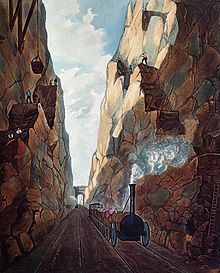Olive Mount cutting
Appearance
| Olive Mount cutting | |
|---|---|
standard gauge |

Olive Mount cutting, which was opened in 1830, is a 2-mile (3.2 km)
cutting on the line to Manchester,[1] 4 miles (6.4 km) from Liverpool.[2] The cutting is 80 feet (24 m) deep[3] and is situated between Wavertree Technology Park and Broad Green railway stations. The railway's engineer, George Stephenson, had hoped to avoid the problem of creating the cutting for the Liverpool and Manchester Railway by routing the line further north.[4] However, that plan was objected to by the Earl of Derby and the Earl of Sefton.[4]
The cutting was originally designed to accommodate two tracks, and was only 20 feet (6.1 m) wide at the top.[5] In 1871, it was widened to allow four tracks to enter Liverpool Lime Street, because traffic had increased considerably since the station opened.[6]
References
- ^ "Olive Mount". Spartacus-Educational.com. Retrieved 26 February 2019.
- ^ "South Liverpool: Wavertree including Mossley Hill". Allertonoak.com. 4 January 2013. Retrieved 10 February 2014.
- ^ "Subterranea Britannica: Sites: Liverpool - Edge Hill Cutting and Tunnels". Subbrit.org.uk. 4 January 2011. Retrieved 10 February 2014.
- ^ a b "Historic Wavertree, Liverpool - The Olive Mount railway cutting". Wavsoc.awardspace.info. 26 February 2000. Retrieved 10 February 2014.
- ^ Ashmore 1982, p. 166
- ^ "Olive Mount Cutting, 1881 - Photos - Our collection - National Railway Museum". Nrm.org.uk. 28 February 2013. Retrieved 10 February 2014.
Sources
- Ashmore, Owen (1982). The Industrial Archaeology of North-west England. Manchester University Press. OCLC 8555887.
External links
Wikimedia Commons has media related to Olive Mount cutting.
